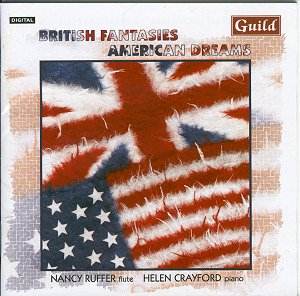Looking at a programme such as this might bring an
uncharitable thought to mind; eclectic or eccentric? In fact, neither.
The recital acts as an arc, beginning with Griffes’ piquant and ravishing
fantasy and ending with his older British contemporary Cyril Scott’s
Lotus land, ever luscious and disarming. The fact that Scott outlived
Griffes by 50 years adds its own depth. Between these succulent pieces
– both in arrangements for flute and piano – comes the most accomplished,
the Piston, the most delightful, the Harty, the most amusing, Beaser’s
1.26 waltz, two intriguing contemporary works dedicated to the flautist,
and Lukas Foss’s Satie and Copland inspired Three American Pieces.
Throughout Ruffer and Crayford exemplify excellent
rapport and instrumental surety. To the Griffes they bring a lyrical
and passionate understanding. Though a late work dating from 1919, and
arranged by the magnificent flautist George Barrere, it loses very little,
if anything, in this guise. Piston’s sonata was written in 1930, ten
years after Griffes’ untimely, obscure death. Evincing his succinct
modernist instincts it is by turns lyrical and kinetic. The first movement
is in triple time, galvanisingly so, the second superbly contrapuntal
and the finale full of his supple lyricism and energy.
Hamilton Harty’s In Ireland is a confection of suitable
airs strung together to form six delightful minutes. Harp imitation
by the piano adds its own pleasures. With Ian Wilson and Peter Fribbins
we are on sterner ground. Inspired by Leon Spilliaert’s 1908 painting
Moonlit Beach Wilson, Belfast born in 1964, explores that work’s
almost abstract quality in a most involving way. A kind of stasis descends
on the music through the use of a descending theme, here on the alto
flute – at Nancy Ruffer’s suggestion – which is at once reflective and
allusive. Porphyria’s Lover by Peter Fribbins takes its title
from the Browning poem and it is by turns fractious, lyrical, skittish
and finally calmly reflective. Its fourteen-minute span tests the stamina
and technique, but both musicians emerge unscathed. Beaser’s Minimal
Waltz is a tiny, insistent and rather memorable thing. Foss’s three
small pieces disclose some evident influences. As the sleeve note writer,
Daryl Runswick, cogently and imaginatively says they are Satie- and
Copland- and neo-classically informed. The second of them, Dedication,
is superbly languorous, the third a rompy moto perpetuo on what Runswick
coyly calls "a famous American national song." Cyril Scott
brings the recital to an end in suitably languid fashion and closes
a most wide-ranging and imaginative disc.
Jonathan Woolf
Hubert Culot has also listened to this disc.
Charles Tomlinson Griffes’ Poem
may be better known in its orchestral guise, but it also works quite
well with piano accompaniment. This, one of Griffes’ last works written
in 1919, is a beautiful song-like fantasy slightly redolent of Debussy.
Walter Piston’s beautifully proportioned, neo-classical
Sonata of 1930 is a fine example of this composer’s well
crafted music and a reminder of his studies with Nadia Boulanger. Three
short movements, never outstaying their welcome, make for a most enjoyable,
tuneful sonatina.
Hamilton Harty’s fantasy In Ireland
was written in 1918 and later scored for flute, harp and orchestra by
the composer (recorded by Bryden Thomson for Chandos some years ago).
There also exists a quite effective arrangement for flute and harp by
Catherine Beynon (available on METIER MSV CD 92006). This is a delightful
medley on Irish tunes.
The Irish composer Ian Wilson has already made
quite a name for himself with an impressive, much varied output including
a number of substantial works such as his organ concerto Rich
Harbour, his three piano trios and his three string quartets.
Ian Wilson’s music often has some extra-musical background, literary
or pictorial, e.g. Giacometti’s works in his Second String Quartet "The
Capsizing Man and other stories" (1994). The short piece for
alto flute and piano Spilliaert’s Beach, written in 1999
for Nancy Ruffer, evokes the Belgian painter Léon Spilliaert
whose painting Moonlit Beach of 1908 is, in its almost minimalist
way, an impressive study in black-and-yellow contrasts. Wilson’s own
brand of minimalism (in this work at least) perfectly matches Spilliaert’s
economy of means. Very simple but highly effective, and a most welcome
novelty.
I must confess that Peter Fribbins’ name and
music are new to me. His Porphyria’s Lover, dedicated
to Nancy Ruffer, is a very fine fantasy in three short sections: a more
animated central section framed by slower ones. The composer mentions
that the piece is based on Browning’s similarly titled poem, which –
to be frank – does not mean much to me, but this elegantly wrought substantial
piece of music of this is quite appealing.
Robert Beaser’s Minimal Waltz
is exactly that: a delightful trifle of great charm playing for just
over one minute.
Lukas Foss’s Three American Pieces
are among his earliest works, written in 1944 and 1945, and thus quite
uncharacteristic of his later style. These short sketches are unashamedly
neo-classical in style, particularly the first two pieces whereas the
concluding Composer’s Holiday is a quick moto perpetuo
in pure Americana with quotations of a familiar American song. Not a
great work but quite enjoyable.
This welcome, well-planned, much varied and beautifully
played collection ends with a quite effective arrangement of Cyril Scott’s
celebrated Lotus Land, originally written for piano.
No reservation whatsoever and heartily recommended.
Hubert Culot

![]() GUILD GMCD 7230 [69.19]
GUILD GMCD 7230 [69.19]